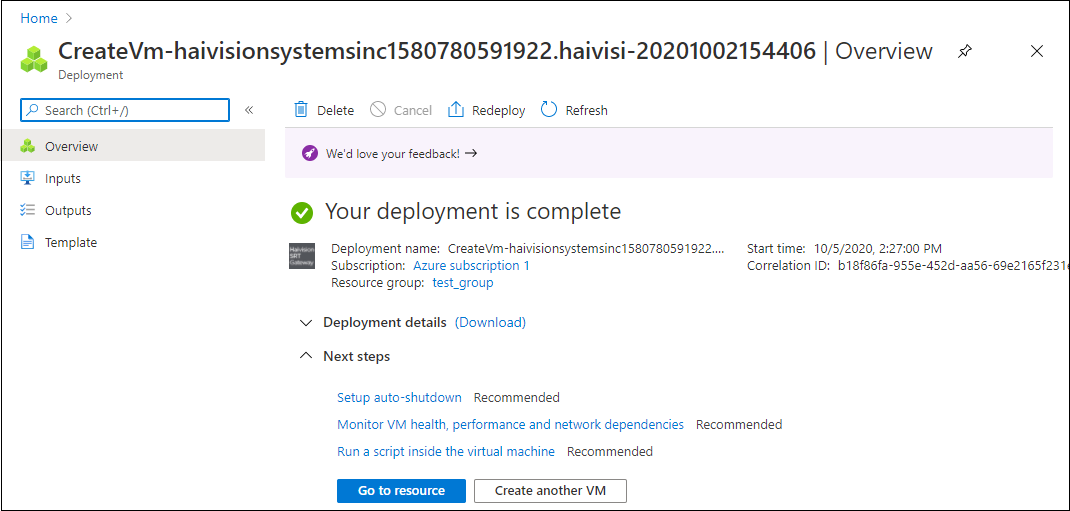Setting Up Your Server
To set up your virtual server, complete each of the sub-sections as described below.
Basics

In the Basics section, specify a subscription plan.
For Resource Group, select an existing resource group. Click Create New to create a resource group, if necessary. For more information on resources, visit: https://learn.microsoft.com/en-us/azure/azure-resource-manager/management/manage-resources-portal
Note
The resource group must be composed of the characters A-Z, a-z, 0-9, period(.), hyphen (-), and/or underscore (_).
Enter a name for your virtual machine instance.
Note
The name must be composed of the characters a-z and/or 0-9.
- Select a region, corresponding to the geographical location closest to the ingest source and/or egress source of your virtual server. This ensures the lowest latency for your Media Gateway/SRT Gateway traffic.
- Select the availability zone(s).
In Size, select from the recommended pricing tiers. For details see: http://azure.microsoft.com/en-us/pricing/details/virtual-machines/
Note
- Currently, we only recommend Compute Optimized F-Series v2 (e.g. F4s v2, F8s v2, etc). Using tiers with lower CPU resources may result in poor performance.
- See the following table for the correlation between the BYOL SKUs and the recommended Azure instance type.
HMG BYOL SKU HSG BYOL SKU Azure Instance vCPUs RAM Suggested # of Routes/Destinations — MI-SG10-AZU-BYOL F4s v2 4 8 GB - 10 Routes with 1 Destination each or
- 5 Routes with 2 Destinations each
MI-MG200-AZU-BYOL MI-SG20-AZU-BYOL F8s v2 8 16 GB - 20 Routes with 1 Destination each,
- 10 Routes with 2 Destinations each, or
- 5 Routes with 4 Destinations each
MI-MG500-AZU-BYOL MI-SG50-AZU-BYOL F16s v2 16 32 GB - 50 Routes with 1 Destination each,
- 25 Routes with 2 Destinations each, or
- 5 Routes with 10 Destinations each
— MI-SG-UL-AZU-BYOL F32s v2 32 64 GB - 100 Routes with 3 Destinations each
- Set up the administrator account by choosing SSH public key for the Authentication type and entering hvroot for the Username.
Generate a SSH public/private key pair for admin access to your virtual server. Typically, this is done on the computer that you will use to manage the server.
Note
SSH access to the Gateway’s Console UI is only allowed via SSH public key. After deploying the virtual server, you can use this console to enable access for other administrators by uploading their public keys.
You can generate an OpenSSH public key with tools like ssh-keygen on Linux and OS X, or PowerShell on Windows. For details, see https://learn.microsoft.com/en-us/azure/virtual-machines/linux/ssh-from-windows and https://learn.microsoft.com/en-us/azure/virtual-machines/linux/mac-create-ssh-keys.
- In SSH public key source, select Use existing public key, and copy/paste your public SSH key into the SSH public key field. Never share the private key.
- When you are satisfied with your settings, click Next: Disks.
Disks
- Select the OS disk and Encryption types. Disk size should be based on the considerations of performance, space, and pricing.
- When you are satisfied with your settings, click Next: Networking.
Networking
- For Public IP address, if a static IP is desired, click Create New and select the desired options.
- For Configure network security group, click Create New and add inbound/outbound rules for each necessary port. See Modifying Network Security Rules for more details.
- When you are satisfied with the settings, click Next: Management.
Management
- Select the desired management/protection settings.
- When you are satisfied with the settings, click Next: Monitoring.
Monitoring
- Select the desired monitoring settings.
- When you are satisfied with the settings, click Next: Advanced.
Advanced
- Select any additional advanced configuration options.
- When you are satisfied with the settings, click Next: Tags.
Tags
- Create any desired tags.
- When you are satisfied with the settings, click Next: Review + Create.
Review + Create
- Review your settings. You can go back to previous sections to make any necessary changes or corrections.
- When you are satisfied with the summary, click Create.
Creating your server instance can take several minutes. After the deployment completes, you can sign in.

